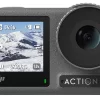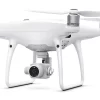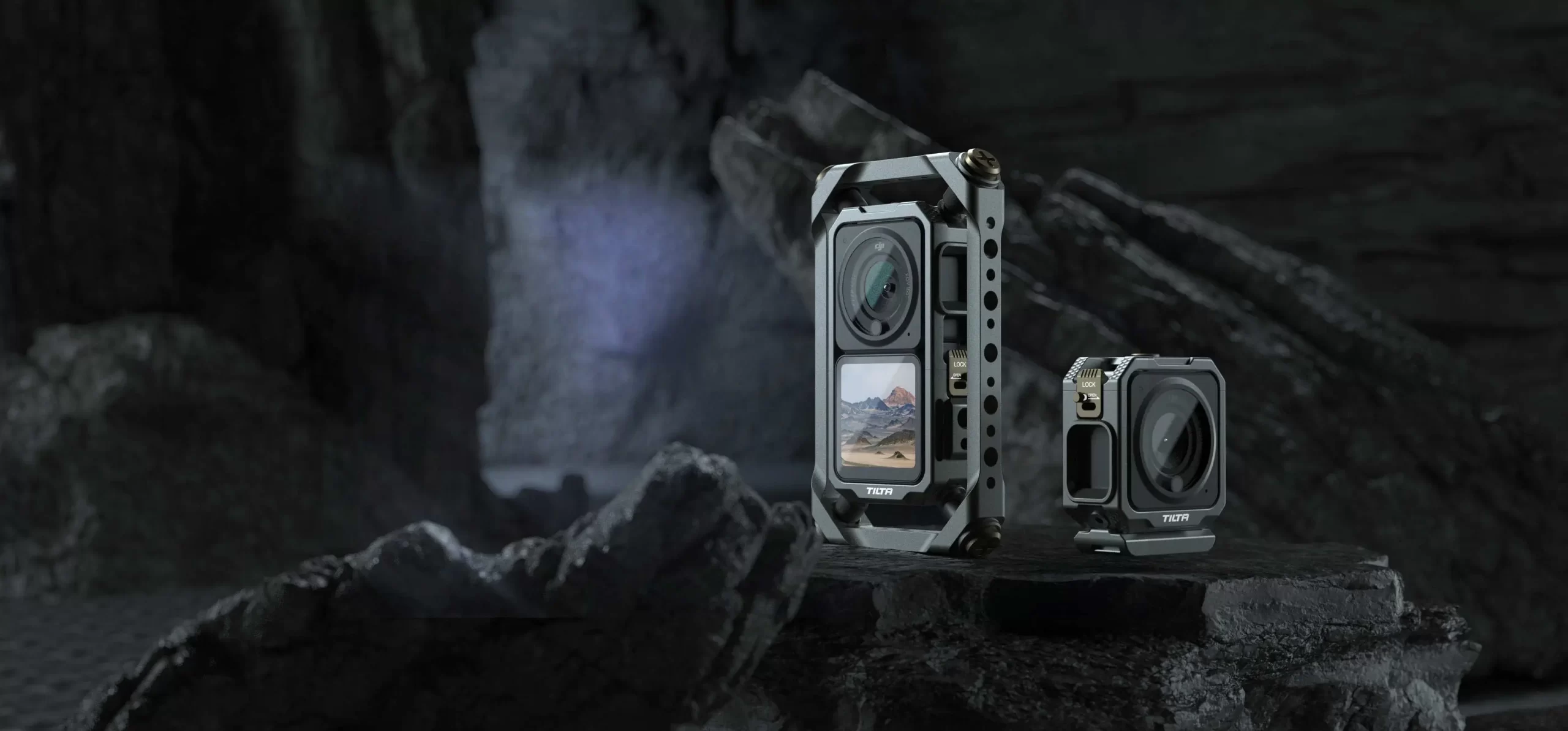
After taking over the drone market, could DJI also take over the action camera industry and dethrone GoPro once and for all?
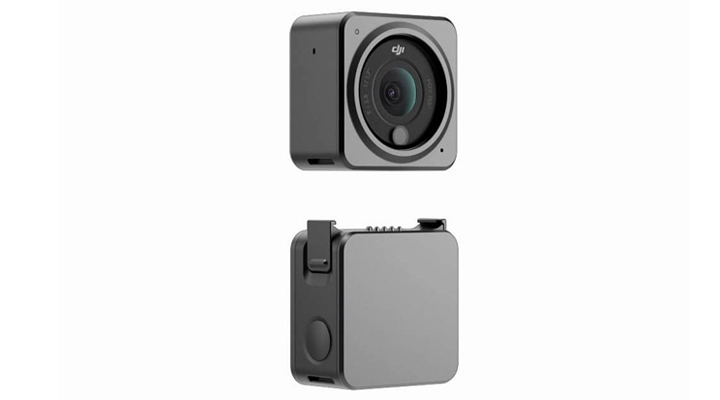
Specifications
| Dimensions | 39×39×22.3 mm |
| Weight | 56 g |
| Obstacle Detection | - |
| Integrated Camera | - |
| Video Resolution | 4K (16:9): 3840×2160 @ 100/120fps |
| Megapixels | 12 PM |
| Media Format | MP4/MOV (AVC/H.264; HEVC/H.265) |
| Remote | No |
The best DJI Action 2 deals
The drone manufacturer is taking another swing at the action camera market with the Action 2, which is a follow-up to the Osmo Action from 2019. Where the Osmo was basically a GoPro clone, the Action 2 changes the game entirely from a design factor. The camera is square, with a lens on the front and a screen on the back, and uses powerful magnets to connect to accessories, such as mounts. It’s an interesting pocket camera that has incredible innovations from a design standpoint, but that isn’t without some drawbacks.
In fact, the Action 2 has quite a big problem with overheating after long-form recording, and it’s easy to imagine losing track of its small components.
On paper, Action 2’s specs are solid. With a 4K video recording at 120FPS, improved motion stabilization, and a host of automatic capture modes and features that have become standard on high-end action cams. However, the GoPro Hero 10 Black is still a very tough opponent to beat.
The GoPro Hero 10 Black is the king of action cameras right now, and although the Action 2 has a lower resolution than its rival, it makes up for it in horizon levelling. DJI calls it Horizon Steady, which creates incredible image stabilization, allowing virtually 180-degree tilts without affecting the image orientation.
The Action 2 has excellent video quality, with a range of shooting modes and an official macro lens accessory. The camera leans towards down-playing saturation, which can result in muddy-looking footage, especially in low light.
The battery life is decent with the power module, but the standalone version probably won’t make it through more than half a day.
What the Action 2 does best is the design. It’s a fraction of the Hero 10 Black, so if you’re looking for the tiniest camera, the Action 2 is arguably the best. Therefore, if you’re a vlogger, the Action 2 takes the cake as a handy, pocket action camera.
Table of Content
Design
Action 2‘s design is extremely bare-bones.
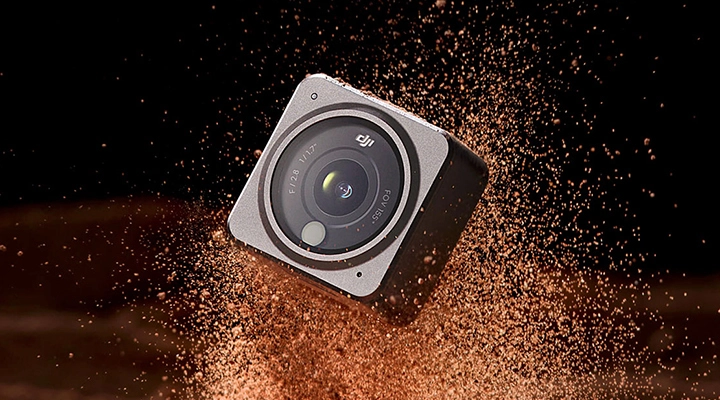
The main module is a tiny square, 3,9×3,9×2,2cm in size and weighing 56 grams. The camera ships with a sidecar module, identical in size, that snaps magnetically to its bottom, doubling both its width and weight.
There are two main kits available, the Action 2 Power Combo is the more affordable one at $399. It includes an add-on Power Module pack to extend battery life and has a USB-C charging port and a microSD card slot, but it’s not waterproof like the camera itself. The second kit, the Dual-Screen Combo, is also an add-on module that includes a battery reserve, USB-C, and a MicroSD slot, but also adds a front-facing touch LCD and three additional microphones at $519. You can get the two add-on modules with the Action 2 camera or purchase them later for $75 and $169.
But the most significant design wow factor of this tiny camera is its magnetic mount, and it snaps onto ferrous objects with ease. You can snap it onto your car’s hood, fridge side, or a metallic bridge. However, the magnets aren’t up for extreme action. You can’t just attach it to your motorbike while speeding at 100kph on the highway, as it will easily fall off. However, the magnets are handy for putting the Action 2 in exciting places.
The Accessories
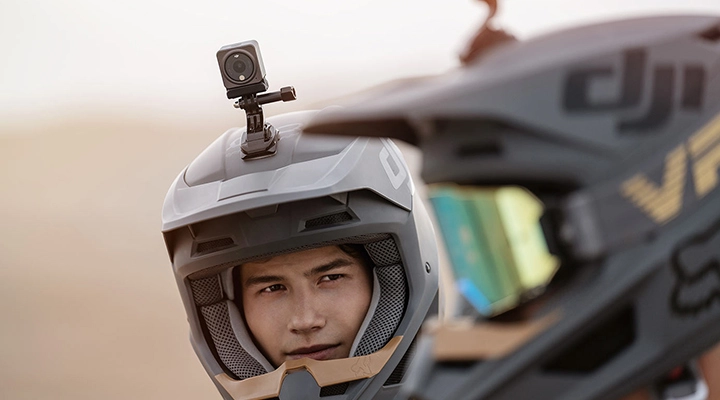
There are some essential accessories included with both kits. You get two camera mounts, one compatible with GoPro mounts and a second standard ¼-20 tripod thread and ball head. Also, you get a magnetic lanyard, a wearable necklace for chest-mounted footage, and a USB-C charging cable that rounds out the included accessories.
That’s it. If you want anything else, it’ll cost extra, and some of the additional accessories are fundamental, in our opinion. For example, a waterproof case is required if you take the camera deep underwater, as only the lens portion of the camera is fully waterproof. To make it fully waterproof, you need an extra case rated to nearly 60m depth. The case costs $65 and fits the front screen or battery add-on.
There’s also a selfie stick with a Bluetooth remote for $75, a floating handle for $49, and a magnetic headband for $35.
Also, if you’re a fan of that, there are lens accessories, such as a $79 close-up option that snaps right on the front with magnets. With a macro lens, the focus range is limited to close, so you’ll want to show the camera right up against what you’re trying to photograph or film.
Touch Controls
The Action 2 has a pretty simple two-button design, one on the primary camera and another on the add-on module, but both have the same function. A long press of these buttons turns the camera on and off, and a short tap starts and stops videos or snaps a photo. So the small touch screen behind the camera is your main control surface.
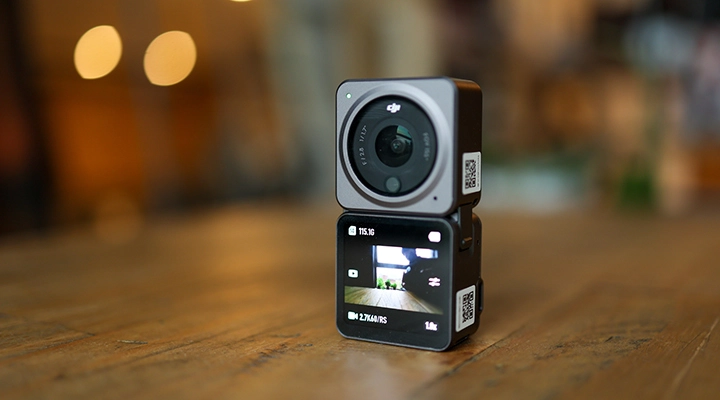
It’s about 2 inches diagonal and can be a little tricky to use. But with a bit of practice and the big icons to swap settings, Action 2‘s touchscreen is not bad.
You can swipe from left to browse media, to the right to change the exposure setting, from the bottom for resolution and frame rate options, and from the top for the full menu. The only tricky part is swapping modes, as you have to swipe to the left or right to change between photo, video, timelapse, quick clip, and slow motion, but you need to make sure you start the swipe from the middle of the screen or else it won’t work.
Surprisingly, the Action 2 also has voice commands and works pretty well. The camera responds to commands like “record”, “stop recording”, and “take a photo.” The voice function can be turned off, and it’s not a bad idea to do so if you’re using it in crowded environments.
You can also fully control the Action 2 via smartphone app, the DJI Mimo, available for both IOS and Android. The app works as expected, presenting a live feed from the Action 2‘s lens on your phone screen.
Regarding modes, photo, video, and slow-motion are self-explanatory. The quick clip mode is excellent for social media, recording 15-second content for you to post easily. Timelapse is a standard feature, however, we like that DJI included presets for crowds, clouds, and sunsets. Lastly, Hyperlapse, you can let the camera decide how much to compress time, or select it manually from 2x,5x,10x,15x, and 30x speed-up options.
You could also use the Action 2 as a USB webcam for conferences or live streams.
The Battery
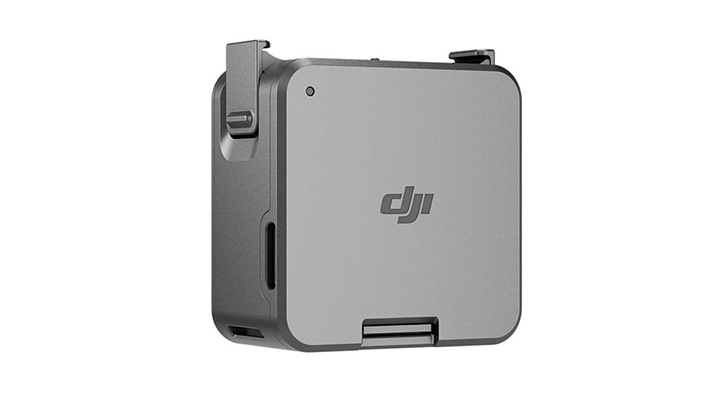
The Action 2‘s main module has its own battery, but it’s pretty underwhelming. It’s only good for about 17 minutes of 4K60FPS recordings and in some cases struggles even after the first 5 minutes of recording at the maximum video resolution.
The front-facing display and battery pack both have their power cells for extended record times. The display module adds about 49 minutes, for a total of 68 minutes of recording with the added module. The battery pack makes the battery last a little bit longer, adding 66 minutes for a total of 83 minutes of record time.
DJI’s Action 2 camera lasts up to 70 minutes when shooting at full HD at 30FPS without the extra battery module.
Overheating
As we mentioned earlier, one of the most significant setbacks of this cubical camera is the overheating issue. The overheating happens mainly with long-form recording, and you can hardly get the Action 2 to record for longer than 15 minutes without it shutting down due to heat.
If long-form recording is something you care about, there are ways to overcome the heating issue. Using a lower resolution and framerate, for instance, or mounting the camera, so it’s cooled by air motion and turning off stabilization for tripod work will help keep the temperature low.
Photos and Video
Action 2‘s photos and video are one of its biggest strengths. It has some real advantages over the Hero 10 Black for extreme sports fans and vloggers, notably a wider angle lens backed by a larger format image sensor. Also, the Action 2’s colour is not as warm as the GoPro‘s counterpart.
In-camera colour options and video control are limited, even when set to Pro mode. You can use DJI’s default colour look, or go for D-Cinelike, a profile with lower contrast and colour saturation, for a flat look. The problem is that shooting with the default colour preset gives dull and uninspired footage.
The camera captures photos at 12MP in JPG or Raw DNG format. The pictures look just as good as the video, with vibrant colors and a dynamic range that’s ample for tough scenes with mixed levels of light. Digital stabilization is fantastic, with DJI’s RockSteady stabilization comparable to the best motion cameras on the market. Angle of view is also incredible in the Action 2, showing a lot of the environment you’re recording.
The DJI Action 2‘s camera features a 1/1.7-inch CMOS sensor with a wide 155-degree field of view and an f/2.8 aperture. Its ISO range starts at 100 and climbs to 6400 across photos and video. The camera caps its videos at 4K, and across stills, video, and horizon levelling, the camera pushes you to shoot at lower resolutions.
Action cameras aren’t generally known for their DSLR-grade image quality. But that doesn’t mean the Action 2 didn’t pack some punches. The camera features a very wide angle, so punching into an object generally leaves it softer. This is an excellent feature for wide shots, but less so if you’re shooting in a bright environment and want to shoot across the wide and ultra-wide field of views.
Audio is a mixed bag. The Action 2 has a single internal microphone, and although it picks up voices clearly, it doesn’t do too well with background noise. The front-facing LCD adds another three mics, however, it still has the same issue with background noise.
Alternatives
We mentioned multiple times throughout this review the GoPro Hero 10 is one of the best alternatives to the DJI Action 2.
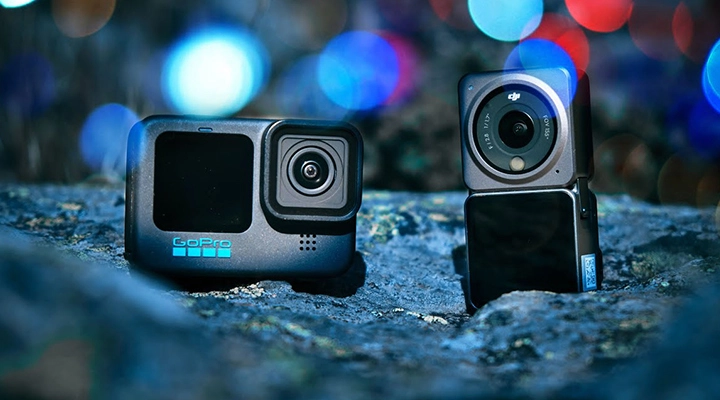
Before the Action 2, the Hero 10 Black was the best action camera you could buy. Is that still the case with the new DJI camera? Let’s see how it compares.
DJI‘s follow-up to the original DJI Osmo hasn’t just taken the easy route and simply made a slightly improved version. Instead, DJI has gone leaps and bounds ahead and taken more cues from GoPro to strengthen its new camera.
Price
As for price, if you simply head to a store and compare the two cameras, the Hero 10 is more expensive at $499 than the $399 required for the Action 2. However, GoPro offers an alternative way to purchase its flagship model: A GoPro Subscription. This subscription plan gets you the Hero 10 Black for $399 plus cloud storage, discounts, and replacements of up to two damaged cameras a year, which means the two cameras have the basically same starting price.
Design
The design could be a deal breaker.
GoPro went for a more traditional design, with the usual bulky design that the company has used for years. On the other hand, DJI completely revolutionized its design with modular technology. With the Action 2, you have the main unit and can attach a battery pack or an additional front display to your main camera. Their modules are connected through clipping magnets rather than just physical sockets.
Size and weight
The modular approach makes DJI‘s camera much smaller and lighter than the GoPro Hero 10. The Action 2 weighs 56g while the Hero 10 weighs 158, almost three times as much. Considering these are travel and vlog cameras, you may find the weight difference quite the deal breaker.
However, Action 2‘s weight doesn’t factor in the extra modules. If we add the additional kit, the weight goes closer to the Hero 10, with a total weight of 112g. On top of that, the fact that the Action 2 is smaller has drawbacks, such as lower water resistance and a higher chance of overheating.
Battery
DJI’s Action 2 camera lasts up to 70 minutes when shooting at full HD at 30FPS with the camera brick alone, while the Hero 10 lasts up to 112 minutes in the same scenario. Recording time drops to 76 minutes in 4K with the Gopro, while the Action 2 drops to around 40 minutes using the 4K mode.
So if you want to shoot longer footage, the Hero 10 is a clear winner here, especially if you shoot videos in higher resolutions. For example, without any modules attached, the Action 2 at 4K60FPS has a maximum recording time of 5 minutes.
Action 2‘s battery becomes s a lot better with the attached battery module, which makes the camera more expensive and heavier. The battery module increases its battery life to 180 minutes at 1080p, around 60% longer than the Hero 10 Black.
Photos and Video
DJI made an interesting choice with its sensor. It’s a 1/1.7-inch sensor, around 35% larger than GoPro‘s. However, the Hero 10 has a much higher resolution with a 23.6MP camera versus the 12MP of the Action 2. On top of that, the Hero 10 shoots video at 5k resolution max, while the Action 2 doesn’t go over 4K.
You could argue that 12MP is the optimal sensor for 4K video resolution, but we have to consider the reality of shooting with an action camera. You often use a significantly cropped view, and the 12MP sensor doesn’t keep up as well as Hero’s 10 23.6MP one.
Still, despite having a lower resolution sensor, the Action 2 has a slightly maximum bitrate than the GoPro. It offers up to 130Mbps against the 100Mbps of the Hero 10.
To top it off, the GoPro offers better maxed-out modes. For example, the slow-mo can shoot at 2.7K resolution at 240FPS, while the DJI’s camera can only handle 240FPS at a resolution of 1080p.
Stabilization
You’re probably not going to get disappointed by either of these cameras’ stabilization. The Action 2 has a technology called RockSteady, while the Hero 10 has Hypersmooth.
Both offer horizon levelling. This keeps your footage upright even if the camera tilts significantly. Naturally, this only works with digitally cropped modes, using the same techniques as normal electronic stabilization.
Both offer an impressive horizon levelling, however, DJI’s RockSteady taps out far earlier. You can use Horizon Steady only at resolutions below 4K, while the Hero 10 has a staggering stabilization in all its modes, including 5k and 2.7K at 240FPS.
So, if you’d like to capture a lot of vlogs where the camera is strapped to your head or your shirt, the DJI Action 2 could be a great solution. If you like filming longer footage, then the GoPro Hero 10 Black is the better option. However, considering prices and specs, the Hero 10 is still the best action camera on the market available today in our opinion.
Pros and Cons
Pros
- Smallest camera around
- Flatter desaturated footage
- Widest angle possible
Cons
- Not shoot long clips
- Not social media ready
- Not the highest quality camera
You should buy the DJI Action 2 if…
- You want the smallest camera around: With its modular design, incredibly compact form, and great in-hand feel, we loved its design as it’s convenient whether you need to take the cube with you on a trip or for a vlog.
- You prefer flatter desaturated footage: DJI adopts the color profile they generally go for with their drones, a more realistic and less saturated look.
- You need the widest angle possible: At 155 degrees, the Action 2 is hard to beat if you want an ultra-wide choice for landscape and all-encompassing footage.
- You’re a vlogger: If you’re a vlogger and need a handy camera that can take amazing shots, or you’re a streamer that can use the magnetic features, you’ll probably find the perfect motion camera for you with the Action 2.
You shouldn’t get the DJI Action 2 if…
- You like to shoot long clips: The Action 2 has a big overheating issue. After 5 to 10 minutes of 4K shooting, it starts to heat considerably. We also found this to be the case at 2.7K resolution as well, and even at 1080p, the camera can shut down sometimes. So the Action 2 is definitely better for shorter clips.
- You want social-media-ready, rich-looking footage: Because the Action 2 gives a more realistic-looking and less saturated look, you probably won’t find it appealing if you’re looking for a vibrant and rich look with your footage.
- You need the highest quality camera: This cube packs a powerful camera, but if you’re looking for the best, you’d better look elsewhere as there are more powerful and expensive options than the Action 2.
Final Words
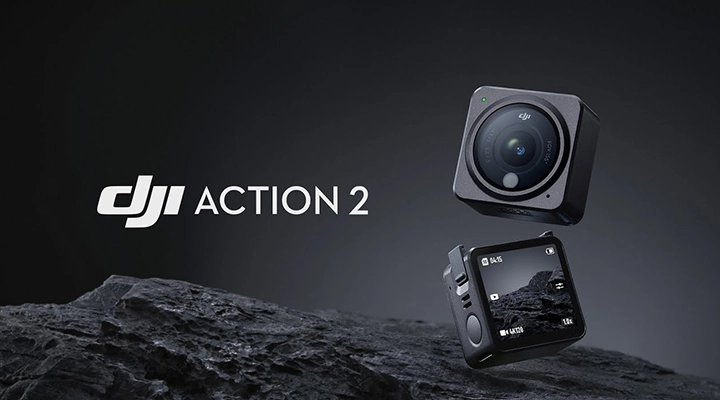
DJI took some time to follow up on their latest action camera, the Osmo, waiting two and a half years to design its sequel. The drone manufacturer took those years to create an incredible design, and we’ll give credit to the functionality of the Action 2‘s modular form factor. The tiny cube can squeeze into interesting places for creative shots, and the magnetic mount is convenient, though it’s nothing game-changing.
But even with all the upgrades compared to the Osmo, the Action2 doesn’t quite manage to outperform its GoPro counterpart. Price is a significant factor, too, as the Action 2 comes at $399 and doesn’t provide a video resolution higher than 4K.
The DJI Action 2 is a bold attempt at an alternative action camera, and while that’s a smart and innovative addition, this does come with practical limitations. The main one it’s limited to shooting short clips due to extreme overheating. Also, the main unit isn’t even completely waterproof, as the main module is only waterproof to 10m.All things considered, the Action 2 is a handy camera that produces good, natural-looking footage. If you’re a vlogger without too many expectations, the Action 2 is a small, versatile little video camera that’s a fun travel companion.

